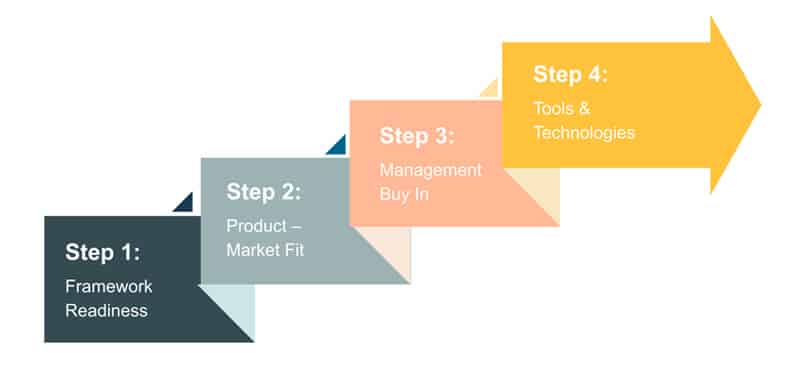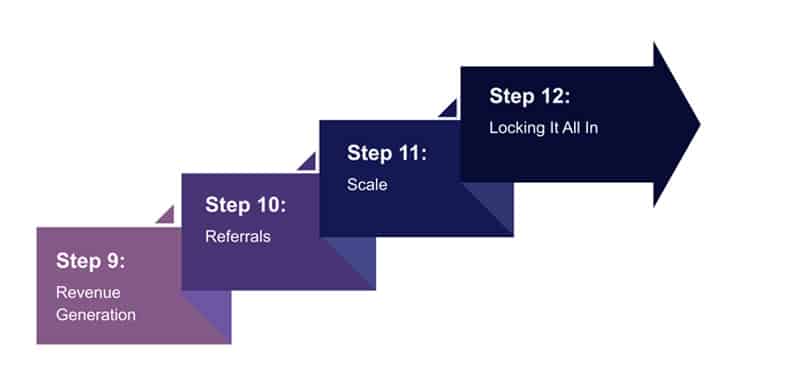Growth Hacking is a relatively new term that has grown exponentially in popularity over the last 5 years. Many people ask, “So what exactly does a Growth Hacker do”? In simple terms, when you consult a growth hacker, you are looking for a way to take your organization to a stage of phenomenal growth. The growth hacker will work with you to systematically explore new opportunities, right from customer acquisition to retention along with product fitment to optimization.

Even though it may sound unconventional, Growth Hacking is anything but a random arrangement of events happening that leave you high and dry at the end of the day. Growth hacking is, in fact, a process-oriented technique that leverages the entire spectrum of the marketing funnel. Yes, there are phases of experimentation and exploration, but that is all done in the spirit of producing growth and new possibilities that may not get considered by applying traditional marketing techniques.
Here is a 12-step growth hacking guide with a description of the activities that need to be done at each step. It is based on the AARRR funnel of growth hacking that has been developed by Dave McClure, a strong proponent of the growth hacking mindset and an enthusiastic founder of the tech incubator/accelerator 500 Startups.
The Sunrise Phase

Step 1: Framework Readiness
The first step is to understand the AARRR framework and apply it as-is or customize it to suit your business model. The five stages of the AARRR framework are:
- Acquisition
- Activation
- Retention
- Revenue
- Referrals
Step 2: Product – Market Fit
The main steps of growth hacking (4-8) usually get done in a rapid fast-paced manner. The product market fitment needs to take place prior so that there is sufficient confidence amongst the team that it is the right product that is getting marketed. Taking user feedback is a great way to determine if they are satisfied with the quality of the product. Such sessions also give an idea of the current retention numbers so that data is available for making the right decisions.
Step 3: Management Buy In
A green signal from the management is one of the prerequisites in the pursuit of new growth. You can then consider new possibilities with an open mind, without thinking of how to convince the team internal of the organization. With an internal buy-in, the focus on external activities can be increased multifold, leading to a substantial increase in results.
Step 4: Tools & Technologies
There is a whole range of automation tools available for your growth hacking exercises, starting from free ones to the more expensive subscription-based models. Some great examples are:
- Zapier – for marketing automation
- GrowthBar – SEO Chrome Extension
- Hotjar – Track user behavior through heatmaps
The High Noon Phase

Step 5: Find the Sweet Spot
You must stay content with the knowledge that your product will not be able to please ALL customers. The sweet spot is that section of customers that like your product. When you successfully identify this segment, you are at your Eureka! point in the journey. Use the 80:20 rule that says that 80% of your profit typically comes from 20% of the Customers. Knowing the characteristics, behaviors, and likes of this 20% and then accordingly focusing on your growth hacking techniques will bring in a positive flow of energy, ideas, and activities that can take your product and startup to the next level of recognition.
Step 6: Acquisition
There must already be some activities of customer acquisition taking place in the organization. The trick here is to find out what works best for the product and then find more techniques in that direction. Commonly used methods are compelling taglines, free demos, referral incentives & gamification.
Step 7: Activation
Activation is about giving an incredible first experience to users when they come in direct contact with the product. Think product tour for new users, video tutorials, streamlined user flows, and personalized onboarding, live chat, and online communities for support.
Step 8: Retention
Traditional marketing budgets allocate more to the initial acquisition and activation activities without thinking much about retention. However, growth hackers often increase retention budgets because customer loyalty is a good thing to have. Use retention techniques like differential pricing, discount rewards & excellent customer care for ensuring that your customers stick around even though there may be similar products vying for their attention.
The Siesta Phase

Step 9: Revenue Generation
Growth hackers usually perform several iterations of idea generation, testing, measure & repeat till the time they find new revenue streams that are sustainable for a significant duration of time. Fortunately, there a quite a few tools out there that make this a fun thing to do. Here are a few examples:
- Masskom – Gamification sales tool
- Amplitude – Provides insights on buying behaviors
- Snip.ly – Increases traffic toward the website by adding a call to action along with shared links
Step 10: Referrals
- You can add a ‘Refer your friends’ link when users are sufficiently engaged with the product rather than at the beginning of the experience.
- Invite referrals that will help in Testing or Evaluating the product
- Take a survey asking if they would like to refer, and then send out a referral link only to those who answered Yes on the survey.
Step 11: Scale
By this step, you have collected sufficient growth hacking intelligence on what works and what doesn’t. You also have a great product with user feedback, data analytics, acquisition, referrals, and retention strategies in place for you to be able to take the scale step. In this step, you find out all the techniques that have resulted in a positive ROI and use them to accelerate growth, by giving the highest priority to the speed of execution over anything else.
Step 12: Locking It All In
Now that the results are starting to come in, successful growth hackers take time to let it all sink in. This is the time when you look back and clean the clutter. Since some steps of the process get done in a rapid execution model, chances are that activities like artifact organization and documentation may have got skipped. This is where you can put it all together and move into a more stable mode of execution from here on.



